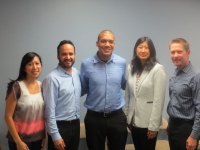
Pictured left to right: Angelica Jongco, Guillermo Mayer, Dimitri Holtzman,
Titi Liu and John Affeldt
Imagine suddenly discovering a distant relative that you never knew existed—a person who despite living half way across the world has a common experience or tradition that you hold as your own. Someone who speaks your language. Now imagine that the relative was an organization, not an individual. That’s how I felt when Dimitri Holtzman walked through our doors.
Dimitri, a founder and director of the South African Equal Education Legal Centre is spending his time these days as a PILnet Fellow at Columbia University in New York. His aim? To spend quality time thinking strategically about the future of his organization’s fight for social justice in South Africa. His recent visit to Public Advocates’ offices reconnected him with people and an organization he knew only from afar, but whose goals and methods mirror his own.
First a little background.
The EELC was founded as the litigation arm of the South African organization Equal Education, which first opened its doors back in 2008. At that time, Equal Education (EE) launched a national campaign to win “Minimum Norms and Standards for School Infrastructure” throughout South Africa – a movement that echoed the long-fought and groundbreaking lawsuit, Williams v. California, filed by Public Advocates, MALDEF and the ACLU in 2000 along with a coalition of civil rights groups and the law firm of Morrison and Foerster. Williams highlighted the fact that California operated thousands of schools without enough textbooks for students; provided school facilities that were overcrowded, in disrepair, and unhealthy for students; and employed many under-trained teachers. In 2004, after more than four years of litigation, the parties announced a settlement agreement that ushered in the implementation of major reforms, including over a billion dollars in state resources to address the underlying issues.
By 2011, three years after its founding, Equal Education was mobilizing thousands of South Africans in defense of their crumbling education system. In fact in March of that year, 20,000 people marched on the South African Parliament to demand for the delivery of a Minimum Norms and Standards for School Infrastructure. These standards were meant to address the terrible conditions at schools across South Africa, where broken windows, non-functioning bathrooms, and resource-less classrooms had become endemic problems. It was at this time that Public Advocates and Equal Education first encountered one another.
Back in 2011, then PA President & CEO Jamienne Studely traveled to South Africa on holiday. In a September 2011 blog entry, Jamie wrote about her decision to visit Equal Justice on the recommendation of the U.S. Ambassador’s wife, education policymaker Liz Berry Gips who, Jamie wrote, encouraged her to meet the “amazing” people at EE.
“She was right. EE is a three-year-old ‘movement of learners, parents, teachers and community members working for quality and equality in South African education, through analysis, policy development and activism.’ The parallels to our coalition-based policy advocacy efforts for ‘quality and equality’ in education in California and the United States were striking. And like us, EE was founded by young lawyers passionate about justice.”
It took five years of dedicated advocacy work, but finally in January of 2013, South Africa’s Education Ministry issued regulations on the Minimum Norms and Standards for School Infrastructure. Today, Equal Education continues its fight for these standards, which are now the law but still need to be widely implemented at the local level. As recently as October, Equal Education reported on its efforts to make these standards a reality:
Today (10/07/15) EE members in Limpopo will be picketing the Limpopo Education Department in demand of the provinces Norms and Standards implementation plans that were meant to be published along with other provincial plans on the 12th of June this year. What Limpopo has published thus far is not a plan but rather a User-Asset Management document. The Minimum Norms and Standards for School Infrastructure established a legally binding commitment on every province to provide the Minister with their implementation plans by 29 Nov 2014. – From the EE website.
In a way, the Equal Education Legal Center and Public Advocates are like two sides of a coin. We started as a litigation shop, and eventually developed a strong policy advocacy and community partnership model. EELC started off as a community-based movement that eventually saw the need to develop strong litigation capacity. Now we’ve both evolved to see the value of a more nimble organizational model that can respond to injustice by marshalling a legal strategy, policy advocacy and the building of community power, in combination.
At our meeting with Dimitri we exchanged notes about the evolution of our organizations, the challenge of recruiting attorneys prepared to work in partnership with community organizers, and the social movements that propelled us to make substantive, meaningful change for the communities we serve in each of our countries.
But like that first meeting with a newly discovered relative, we finished the conversation with a profound desire to continue discussing our work, to collaborate, and to connect with those shared human experiences that are known to bridge the widest of distances.

